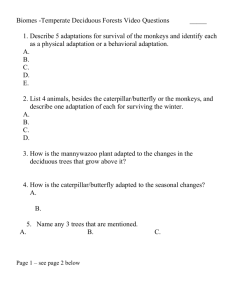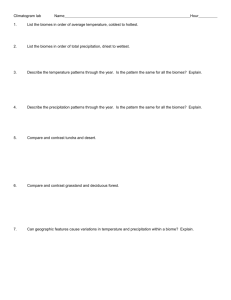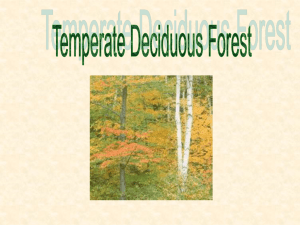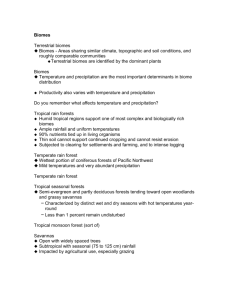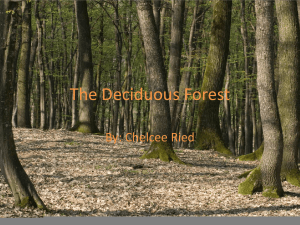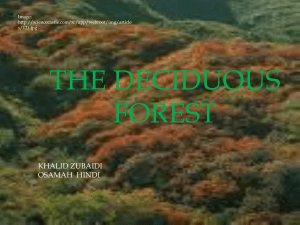Mackenzie Coyne. Nicholas Curtis. Jacob Cohen
advertisement
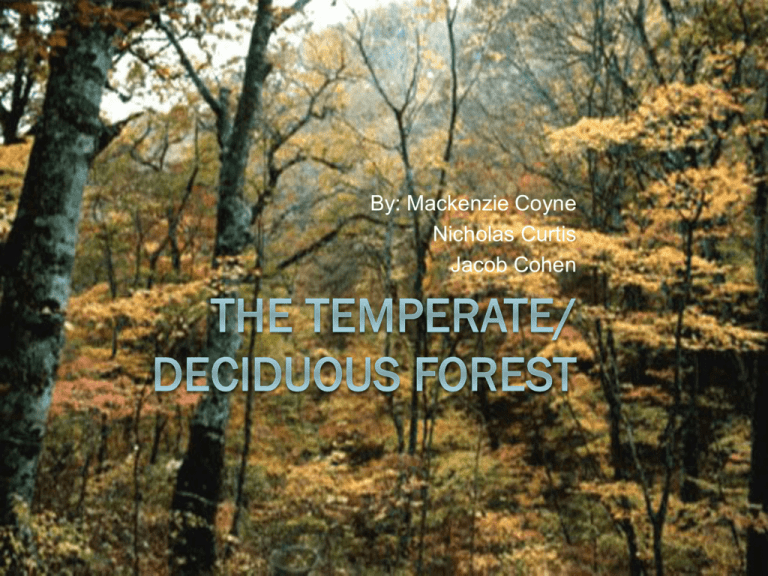
By: Mackenzie Coyne Nicholas Curtis Jacob Cohen Temperature The temperature varies from 30 to -30 degrees Celsius. 30 degrees high 25 degrees 20 degrees 15 degrees 10 degrees 5 degrees 0 degrees -5 degrees -10 degrees -15 degrees -20 degrees -25 degrees -30 degrees low Average Yearly Precipitation Do you know what the average yearly precipitation of a deciduous forest is? Well if you don’t, you’re in luck because I’m here to tell you. Okay are you ready? Good, now the average yearly precipitation in centimeters is 75-150 centimeters per year! That’s quite a bit! Well you wondering people out there, now you know! Animals One animal that lives in the deciduous forest is a Bald Eagle. An adaption of the bald eagle is it`s amazing eyesight. Another animal that lives there is the American Black Bear. One adoptions is its ability to climb. Plants White Oak: Most common tree species in the eastern US. It can get up to 100 ft tall so it can easily get sunlight. Produces acorn seeds with hard shells so only squirrels can get into them. Adapted because it has leaves that are open and wide, so they can easily soak up sunlight. Lady Fern: They have adapted to be able to get obtain some sunlight from the little amount that comes through the tall trees. Their seed are attached to the underside of their leaves, so at the slightest breeze, they will fall off so they can reproduce. Location, Location, Location! Deciduous Forests are located all around the world. They are located right in our backyard! It’s even located all along the Eastern half of America. They are as well located in the middle of Europe! Did you now that there are deciduous forests in Japan, Southeastern part of Russia, and East China? Deciduous Forests are even on the Southern most tip of South America! Eastern Australia and all of New Zealand even have these types of forests! Food chain A food chain in the deciduous forest would be a fly is eaten by a frog, the frog is eaten by a snake, the snake is eaten by a Bald Eagle, the bald eagle dies and is decomposed by bacteria and mushrooms. Fun Facts! There are five different zones in the deciduous forest. The Tree Stratum Zone is the first. It contains tall trees from 60 to 100 feet tall. The Small Tree and Sapling Zone is the second. It has, as it says in the name, small and young trees. Next is the Shrub Zone, which has (well who would’ve guessed) shrubs in it! The Herb Zone, which comes forth, does herbal plants in it, but also has other short plants. Lastly is the Ground Zone. This zone is full of mostly mosses. Deciduous means falling off or at a certain season. That of course, is how the forest got its name because of the trees there, their leaves fall off. There aren’t many original deciduous forests left, because people keep clearing them out and building cities. Many animals here are camouflaged to look like the ground of the forest. Bibliography “Deciduous Forest.” Blue Planet Biomes. n.p. 2000. Web. 21 September 2010. < http://www.blueplanetbiomes.org/deciduous_forest.htm> Bottom right picture on slide eight: Deciduous Forest. (Image). 22 September 2010. www.msu.edu/course/isb/202/tsao/notes/inotes/10_02_09_Ecosystems.html "forest." Encyclopædia Britannica. Encyclopædia Britannica Online School Edition. Encyclopædia Britannica, 2010. Web. 23 Sept. 2010 <http://school.eb.com/eb/article-9034863>. J.R., Will. “White Oak.” Blue Planet Biomes. n.p. 2001. Web. 20 September 2010. < www.blueplanetbiomes.org/deciduous_plant_page.htm> Top right picture on slide five: Illinois State Tree: White Oak Fruit (acorns). (Image). 22 September 2010. <http://www.netstate.com/states/symb/trees/il_white_oak.htm> “Lady Fern.” Blue Planet Biomes. n.p. 2002. Web. 21 September 2010 < www.blueplanetbiomes.org/deciduous_plant_page.htm> Bottom right picture on slide five: Lady Fern. (Image). 22 September 2010. < www.fs.fed.us/wildflowers/plant-of-the-week/athyrium_filix-femina.shtml> Picture on title slide: Ogawa Forest Reserve. (Image). 22 September 2010. < www.ffpri.affrc.go.jp/labs/femnet/ogawa/ogawa.htm> T., Connie. “Deciduous Forest.” Blue Planet Biomes. n.p. 2001. Web. 21 September 2010. <www.blueplanetbiomes.org/deciduous_forest.htm> Top right picture on slide eight: Temperate Deciduous Forest. (Image). 22 September 2010. < http://earthobservatory.nasa.gov/Experiments/Biome/biotemperate.php>



